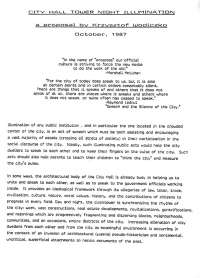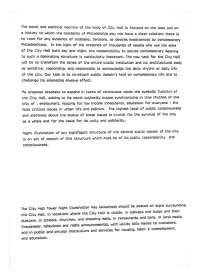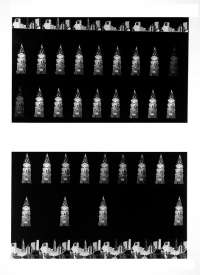"In the name of "progress" our official culture is striving to force the new media to do the work of the old." -Marshall McLuhan
"For the city of today does speak to us, but it is also at certain points and in certain orders remarkably silent. There are things that it speaks of and others that it does not speak of at all. there are places where it speaks and others where it does not speak, or quite often has ceased to speak.'' -Raymond Ledrut ''Speech and the Silence of the City."
Illumination of any public institution, and in particular the one located in tne crowded center or the city, is an act of speech which must be both assisting and encouraging a vast majority of people (crossing all strata of society) in their participation in the social discourse of the city. Ideally, such illuminating public acts would help the city dwellers to speak to each other and to keep their fingers on the pulse of the city. Such acts should also help parents to teach their children to "think the city" and measure the city's pulse.
In some ways, the architectural body of the City Hall is already busy in helping us to unite and speak to each other, as well as to speak to the government officials working inside. It provides an idealogical framework through its allegories of law, labor, trade, civilization, culture. nature, moral history, and the contributions of citizens to progress in every Field. Day and night, the clocktower is synchronizing the rhythm of the city: walk, vast constructions, real estate developments, revitalizations, gentrifications, and rezonings which are progressively fragmenting and dispersing blocks, neighborhoods, communities, and on occasions, entire districts of the city. Increasing alienation of city dwellers from each other and from the city as meaningful environment is occurring in the context of an invasion of architectural (yuppie) pseudo-historicism and sentimental, uncritical, superficial attachments to heroic monuments of the past.
The moral and political machine of the body of City Hall is focused on the past and on a history to which the residents of Philadelphia may not have a clear relation; there is no room for any evidence of problems, tensions, or desires experienced by contemporary Philadelphians. In the light of the presence of thousands of people who use the area of the City Hall both day and night, the responsibility to secure contemporary meaning to such a dominating structure is particularly important. The new task for the City Hall will be to transform the sense of the entire public institution and its architectural body as sensitive, responding, and responsible to acknowledge the daily rhythm or daily life of the city. Our task is to re-attach public domain's hold on contemporary life and to challenge its alienating elusive effect.
My proposal attempts to expand in terms of continuous needs the symbolic function of the City Hall, adding to its moral authority pulses synchronizing in time rhythms of the city of : employment, housing for low income inhabitants, education for everyone - the most critical issues in urban life and politics. The highest level of public consciousness and alertness about the status of these issues is crucial for the survival of the city as a whole and for the basis for its unity and solidarity.
Night illumination of any significant structure of the central public domain of the city is an act of speech of this structure which must be of its public responsibility and consciousness.
The City Hall Tower Night Illumination Key (attached) should be posted on signs surrounding the City Hall, in locations where the City Hall is visible, in subways and buses and their stations, in schools, churches, and shopping malls, in restaurants and bars, in local media (newspaper, television and radio announcements), with utility bills mailed to customers, and in public and private institutions and services for housing, labor & unemployment, and education.
"In the name of "progress" our official culture is striving to force the new media to do the work of the old." -Marshall McLuhan
"For the city of today does speak to us, but it is also at certain points and in certain orders remarkably silent. There are things that it speaks of and others that it does not speak of at all. there are places where it speaks and others where it does not speak, or quite often has ceased to speak.'' -Raymond Ledrut ''Speech and the Silence of the City."
Illumination of any public institution, and in particular the one located in tne crowded center or the city, is an act of speech which must be both assisting and encouraging a vast majority of people (crossing all strata of society) in their participation in the social discourse of the city. Ideally, such illuminating public acts would help the city dwellers to speak to each other and to keep their fingers on the pulse of the city. Such acts should also help parents to teach their children to "think the city" and measure the city's pulse.
In some ways, the architectural body of the City Hall is already busy in helping us to unite and speak to each other, as well as to speak to the government officials working inside. It provides an idealogical framework through its allegories of law, labor, trade, civilization, culture. nature, moral history, and the contributions of citizens to progress in every Field. Day and night, the clocktower is synchronizing the rhythm of the city: walk, vast constructions, real estate developments, revitalizations, gentrifications, and rezonings which are progressively fragmenting and dispersing blocks, neighborhoods, communities, and on occasions, entire districts of the city. Increasing alienation of city dwellers from each other and from the city as meaningful environment is occurring in the context of an invasion of architectural (yuppie) pseudo-historicism and sentimental, uncritical, superficial attachments to heroic monuments of the past.
The moral and political machine of the body of City Hall is focused on the past and on a history to which the residents of Philadelphia may not have a clear relation; there is no room for any evidence of problems, tensions, or desires experienced by contemporary Philadelphians. In the light of the presence of thousands of people who use the area of the City Hall both day and night, the responsibility to secure contemporary meaning to such a dominating structure is particularly important. The new task for the City Hall will be to transform the sense of the entire public institution and its architectural body as sensitive, responding, and responsible to acknowledge the daily rhythm or daily life of the city. Our task is to re-attach public domain's hold on contemporary life and to challenge its alienating elusive effect.
My proposal attempts to expand in terms of continuous needs the symbolic function of the City Hall, adding to its moral authority pulses synchronizing in time rhythms of the city of : employment, housing for low income inhabitants, education for everyone - the most critical issues in urban life and politics. The highest level of public consciousness and alertness about the status of these issues is crucial for the survival of the city as a whole and for the basis for its unity and solidarity.
Night illumination of any significant structure of the central public domain of the city is an act of speech of this structure which must be of its public responsibility and consciousness.
The City Hall Tower Night Illumination Key (attached) should be posted on signs surrounding the City Hall, in locations where the City Hall is visible, in subways and buses and their stations, in schools, churches, and shopping malls, in restaurants and bars, in local media (newspaper, television and radio announcements), with utility bills mailed to customers, and in public and private institutions and services for housing, labor & unemployment, and education.


